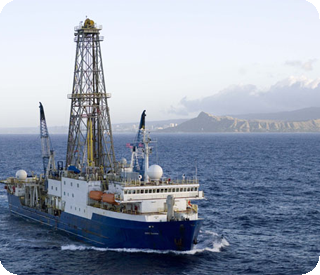|
Deep Sea Drilling Project DSDP
|

The JOIDES Resolution, the new deep sea research ship!
|
 The JOIDES Resolution, the new deep sea research ship! |
|
Mrs. Paluso was part of the scientific technician team that sailed around the world aboard the Glomar Challenger (see a picture at first link) as part of the Deep Sea Drilling Project. This is a collection of information and links she now uses in the classroom. Dr. Jerry Winterer once explained, "(The) Glomar Challenger unlocks the earth's mysteries." (Struhs,A.,p 8-12.) And it did! The Deep Sea Drilling Project (DSDP) was an international study of the global oceans, started in 1968 and supported by the U.S. National Science Foundation (NSF)and the governments of the former Federal Republic of Germany, France, Japan, the United Kingdom, and the former Union of Soviet Socialist Republics. Deep Sea Cores were collected and data compiled by the DSDP from 1968 through 1987 under the auspices of the Scripps Institution of Oceanography, the science operator of the DSDP. Dr. Ken Hsu in his book, Challenger at Sea, states that the Glomar Challenger's contributions to scientific understanding were of enormous significance. From core samples retrieved on her earliest voyages—which JOIDES called "legs"—geologists were able to establish that Alfred Wegener's theory of continental drift, first advanced in about 1915 and subsequently debunked by U.S. geologists, was in fact correct. Researchers were also able to prove the theory of seafloor spreading and determine the age of the seafloor, which was put at about 38 million years. Later voyages also demonstrated that Earth's magnetic poles have reversed themselves repeatedly over time. During fifteen years of operation, Glomar Challenger operated in all the major seas of the world from the Arctic Ocean to the Ross Sea and the Mediterranean and Black Seas. After her ninety-sixth leg, in the Gulf of Mexico, the Glomar Challenger was scrapped at Mobile in 1983, but drilling continued with a new ship and a new program name. Aboard ship Mrs. Paluso sailed as an assistant curator and micropaleontology technician. In the shipboard lab, she worked with the micropaleontologists preparing radiolaria, foraminifera and nannoplankton samples for study and age determination of the sea floor samples. As an assistant curator, she worked under Dr. Bill Riedel implementing sample policy with scientists from all over the world. Many of the Pacific Ocean cores are still stored and accessed at Scripps Institute of Oceanography. The Deep Sea Drilling Project continued under the name International Program of Ocean Drilling (IPOD) and then Ocean Drilling Program (ODP) now based at Texas A&M University, and sailing the newer ship, the JOIDES Resolution. The Resolution traveled the world drilling and sampling the ocean floor. Mrs. Paluso was able to take the Harborside Middle School students (the only K-12 San Diego students) aboard the ship in January 2002, when the Resolution made one of her rare visits to San Diego. When the JOIDES Resolution arrived in St. John's, Newfoundland on September 6, 2003, it was thought that it had completed its last Ocean Drilling Program (ODP) journey. Between 1985 and 2003, ODP had conducted 110 scientific expeditions (legs) in all oceans except for the ice-covered Arctic. It had drilled 650 sites around the world during those 18 years. The JOIDES Resolution was demobilized on 30 September 2003, the last day of the Ocean Drilling Program when they thought she would not continue to sail. However, Drilling DID continue as the Integrated Ocean Drilling Program (IODP), which started in June 2004. The JOI Alliance (Joint Oceanographic Institutions, Inc., Lamont-Doherty Earth Observatory, and Texas A&M University) was selected as the IODP Riserless Vessel Systems Integration Contractor. The JOIDES Resolution (newly remodeled & mobilized!) did again sail for the first few years of IODP. The ship was operated by the JOI Alliance (Lamont, TAMU,& JOI), as the Integrated Ocean Drilling Program (IODP). IODP is an international research program that explores the history and structure of the earth as recorded in seafloor sediments and rocks. IODP builds upon the earlier successes of the Deep Sea Drilling Project (DSDP) and the Ocean Drilling Program (ODP). There were even Teachers-at-Sea! Then in 2006 after 20 years of service, the JOIDES Resolution, the pioneering scientific ocean drilling vessel that has allowed scientists to retrieve samples of the Earth’s crust and sediments from deep beneath the ocean, began an extreme makeover. The new and improved vessel promised to improve the quality and rate of core samples brought up from the deep. Project directors estimated the new ship would be ready for science expeditions in mid-2007. Well, she actually sailed in April, 2009! See her story and videos, blogs, and activities! She is alive and well and now more accessible to teachers & students than ever! In addition, Japan has developed a new research vessel, the Chikyu for the future! Scientists are currently at sea! Check out last two links! Check out ALL the Links! |
Links:
|